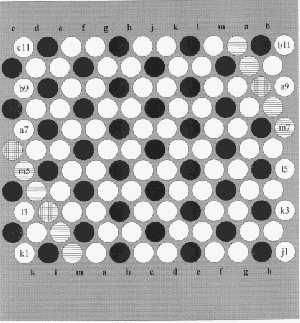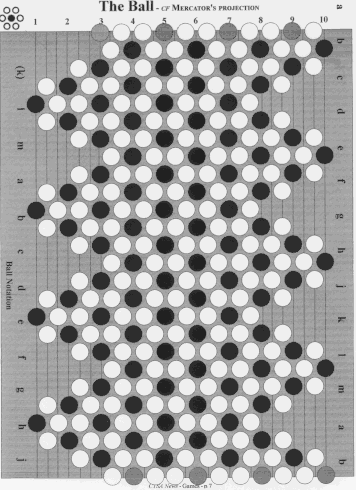The centre of the board forms the Rose. As stated in the newsletter:
The board is derived from the Alban Rose, a symbol of witness (martyrdom) worn by Christian pilgrims The Rosebud Pattern and adopted by the Tudors.
Apart from Rose Chess, the newsletter also describes Rose Draughts, Rose Chess for Three, Corner Rose Chess which are also played on the board shown below, and several other games, played on boards of a different shape.
There are also other variants in the booklet, with different shaped boards, still with the rose pattern: cylinder and a ball.
Many rules are as in chess. Movement is similar to other hexagonal chess variants, like Glinski's Hexagonal chess. Rooks, bishops, queens, and knights move exactly like in Glinski's Hexagonal chess. Kings do so too: they can move one square in one of the twelve directions.
Pawns move without capturing one square forward on a bishop-line (i.e., in three different directions: straight forward, to the left (bishop-like), or to the right (bishop-like)), but capture forward on a rook-line, i.e., to one of the two circles directly in front of the pawn. When they reach the last row (at the side of the opponent), they promote, to a queen, rook, bishop, or knight to the choice of the owner.
Mate, stalemate, check, are like in orthodox chess. There is no castling.
The opening setup is as follows:
B R Q K R B
. N . B . N .
. P P P P P P .
. . . . . . . . .
. . . . . . . . . .
. . . . . . . . . . .
. . . . . . . . . .
. . . . . . . . .
. p p p p p p .
. n . b . n .
b r q k r b
Corner chess
This variant of Rose chess has the following modification to the rules
of that game: pawns move without capturing on rook-lines and capture on
bishop-lines, always one square forwards. Pawns promote on the
corner rear ranks, i.e., two of the four sides left and right
of the board.
Rose Chess for Three
The game is played as Rose chess, but with three players: rotate the
setup of one player 120 or 240 degrees to get the setup of the others.
No specific rules how to win the game are given, or what to do when one
player is stalemated, etc.
More variants
The newsletter describes more variants, on different boards: a cylinder
and a ball. By considering the left and the right of the board adjacent,
we get a kind of three-dimensional shaped board (represented still on a
flat surface.)

The pieces are set up like in Rose chess. The pieces of white are from a1 to f1; the pieces from black at the other side from f11 to l11.
Ball Chess is almost impossible - ranks and files "curve" at the places linked by lines. It makes an interesting area to study endgames.
